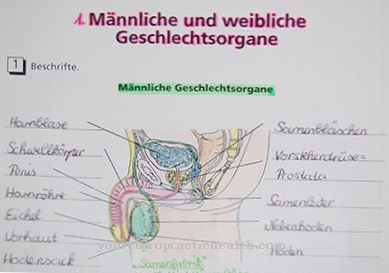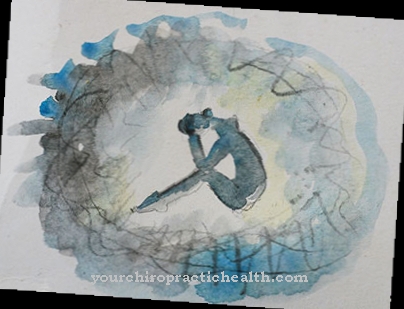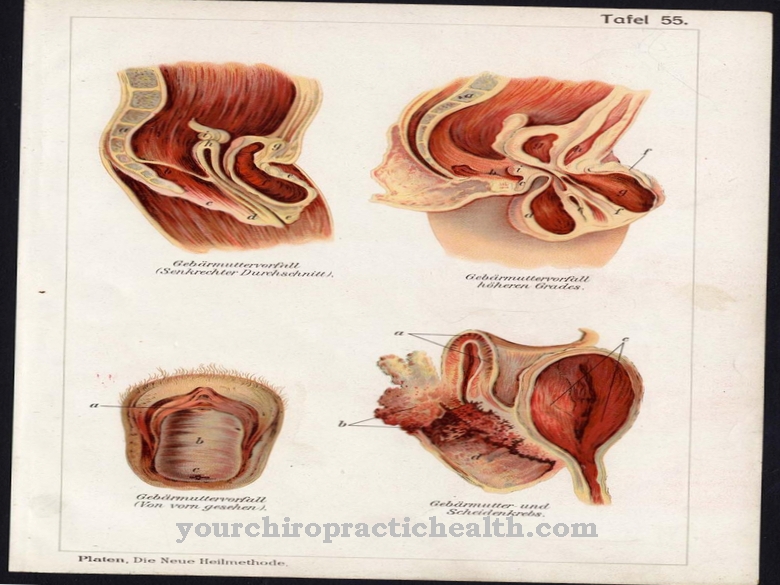Tall stature or Tall stature (macrosomia)can be a family-related variant, but also a serious illness. Tumors or various hereditary factors are the cause. Medical help is recommended in any case of tall stature.
What is tall stature?

© xixinxing - stock.adobe.com
Tall stature the doctors define on the basis of a body length that is above the 97th percentile. This means that a person is one of the 3% of the tallest members of his sex in the same age group.
A common classification divides the phenomenon of tall stature into two groups: The Macrosomia (tall stature)which by definition is more than 1.92 m in length for men and over 1.80 m for women.
From Gigantism (gigantism) one speaks when men are over 2.00 m and women are over 1.85 m tall. The underlying causes are initially not taken into account in this definition. Doctors speak of primordial tall stature in the case of a genetically determined and not pathological, above-average body size that does not result in any complications.
If the causes are disease-related, growth disorders result, which result in disabilities. Hereditary diseases and hormonal disorders are the cause of gigantism in tall stature.
causes
Tall stature The pathological manifestation often results from a hormonal imbalance. In most cases, disorders in the pituitary gland (pituitary gland) during the growth phase are responsible.
It is benign tumors that interfere with the production of growth hormones in the central endocrine gland. Tumors can occur in the pancreas, the tissues of which produce a growth hormone. This shifts the endocrine (hormonal) balance.
An overactive thyroid gland (hyperthyroidism) in the newborn also carries the risk of hormone-related tall stature. The hormonal factors also include diabetes in the mother that occurs during pregnancy (gestational diabetes).
Furthermore, chromosomal gene defects such as Marfan and Sotos syndrome have been described as triggering tall stature. In Klinefelter's syndrome there is an excess X chromosome (sex chromosome) in men (chromosome aberration) and causes a pathological tall stature.
Symptoms, ailments & signs
Tall stature can be clearly diagnosed based on the characteristic symptoms. The disease can be recognized primarily by the above-average height of those affected. Most of the affected children experience severe growing pains.
Intense pain in the bones, joints and muscles occurs especially during puberty. Tall stature can also trigger extreme growth spurts and thereby cause joint and bone diseases. In the course of the disease, other complaints such as inflammation, circulatory disorders or poor posture can occur. In the long term, tall patients experience health problems such as back pain, poor posture and, in individual cases, nerve damage.
Depending on the underlying cause of the tall stature, neurological complaints can also occur. If a tumor disease is the cause, corresponding symptoms appear, i.e. neurological disorders, visual disturbances, pain attacks and an increasing feeling of illness. If the tall stature is based on a hormonal disorder, there is also a strong feeling of malaise, often accompanied by complaints of the immune system and the psyche.
An overactive thyroid can cause gastrointestinal complaints, skin changes and a number of other accompanying symptoms. The main symptom of tall stature, i.e. the enormous body size, cannot be reversed by treatment. Any accompanying symptoms usually subside completely after the growth spurt.
Diagnosis & course
Tall stature should be examined by a doctor if there are abnormal growth spurts. He can determine whether it is a disease or whether it is based on a simple normogenetic disposition. The blood laboratory values provide information about the hormone status, which requires a radiological diagnosis in the event of deviations. If necessary, magnetic resonance imaging can also be used.
The course of a pathological tall stature is very different depending on the shape and therapy options. Hormone-related giant stature leads to unbalanced bone growth. In some cases serious orthopedic diseases result. This can be expressed as partial gigantism and only affect parts of the body. In the case of premature puberty (precocious puberty), secondary sexual characteristics develop in tall stature as early as the age of 10.
Complications
The tall stature does not always have to lead to complications or discomfort. In some cases this is genetic and therefore does not need to be treated by a doctor. In children, the tall stature leads to growth disorders that can be associated with pain. It is not uncommon for children to be bullied or teased because of their tall stature, which can lead to psychological complaints.
The tall stature can also lead to uneven growth of the bones, resulting in deformities or restricted mobility. Furthermore, there is usually an early development of the sexual organs. The treatment of this disease is always based on the cause and is causal. Usually there are no further complications.
In the case of a tumor, it can be removed, usually using radiation therapy. Therapy with hormones is also possible to counteract and stop tall stature. It is not uncommon for those affected to need therapy from an orthopedist and also from a psychologist. This can prevent consequential damage in adulthood. Life expectancy is not reduced by the tall stature.
When should you go to the doctor?
If the child complains of severe pain as they grow, a doctor is recommended. Often the causes of tall stature are natural, but occasionally a disease is the cause that needs to be clarified and treated. Parents who notice such signs in their child should therefore consult a doctor. This is especially true if there is a suspicion of a serious underlying disease. Unusual tenderness or changes in personality should be clarified quickly.
There may be a tumor or a hormonal disorder that requires therapeutic treatment.Infants who have been diagnosed with hyperthyroidism are particularly prone to hormone-related tall stature. Parents of affected children should consult their pediatrician regularly and arrange for an examination in the event of unusual symptoms. If there are cases of chromosomal genetic defects in the family, the child should be examined promptly after birth. In the case of inheritance, further treatment steps must be initiated in order to counteract the tall stature and other side effects of the respective syndrome.
Doctors & therapists in your area
Treatment & Therapy
Tall stature treatment requires intervention in the growth phase. If there is an underlying tumor, surgical intervention may be possible in some cases. However, such operations on the pituitary gland are very risky.
Since the tumors are usually not malignant (malignant), surgery is often not absolutely necessary. Alternatively, there is the option of radiation or chemotherapy. To avert a growth disorder, the doctor can arrange hormone therapy. Estrogens and progestins are female hormones that are used accordingly in girls. In boys, on the other hand, the male hormone testosterone causes a premature end to the growth in length.
If the doctor diagnoses gestational diabetes in the mother-to-be, the temporary diabetes must be optimally adjusted. In this way the physician can counteract excessive growth of the womb. If medical intervention comes too late in the course of adolescence, only later treatment of the symptoms in the adult remains. Especially in the case of gigantism, the orthopedic surgeon is asked to treat the consequences of the unbalanced bone growth.
The genetically caused variants of tall stature often require speech therapy because speech development is delayed. In the case of Marfan syndrome, additional cardiovascular diseases may have to be treated. Overall, a broad spectrum of symptoms is characteristic of tall stature.
Outlook & forecast
The prognosis of tall stature depends on the cause and the time of treatment. If the patient is already fully grown, no further reduction in height can be achieved. Those affected are tall for life and can receive psychotherapeutic care to better deal with their physical size. The body only begins to reduce its height by a few centimeters in advanced adulthood due to its natural course.
In most cases, tall stature is triggered by a genetic disposition or hormonal disorder. Since an intervention in the genetics of humans is not permitted under today's legal conditions, no change in the genetic material can take place. However, if the family is tall, a genetic test can be carried out on the offspring at an early stage and, if desired, treatment can be initiated during the growth and development process. If there is a disorder of the endocrine system, the prognosis is usually optimistic. The administration of appropriate hormonal preparations during the growth phase of the body can dampen growth. In many patients, the physical abnormalities are less of a problem with tall stature. Rather, there are emotional or mental problems due to the visual flaw. In individual cases, it should therefore be checked whether psychotherapeutic treatment is sufficient to mentally not classify tall stature as a disease.
prevention
Tall stature it is difficult to prevent. Only in the case of gestational diabetes can preventive success be achieved by checking the blood sugar of the expectant mother. In adolescents, early detection of the syndrome is crucial for any therapeutic success in tall stature.
Aftercare
In the case of tall stature, in most cases the affected person has either very few or no aftercare measures available. The disease cannot be treated either, as it is usually a genetic disease. However, the earlier a doctor is contacted, the better the further course of the disease, as this can prevent further complications or complaints.
The parents of the affected child should therefore consult a doctor at the first signs and symptoms of the disease. If the person concerned wishes to have children, genetic counseling or testing can also be carried out to prevent the disease from recurring. In many cases, those affected suffer from mental disorders or from depression.
In order to alleviate this, intensive discussions with parents or friends are usually necessary. However, if the tall stature is caused by a tumor, it must be surgically removed. The further course of the disease depends heavily on the time of diagnosis, so that no general prediction can be made. The patient's life expectancy may also be reduced due to the tall stature.
You can do that yourself
If the growth is not yet complete, today's medicine offers the possibility of treating the artificially gradually brought about synostosis of the epiphyseal plates of the tubular bones, which lead to slower subsequent growth. In girls, this is done through therapy with estrogens and, if necessary, with gestagens. In boys, the therapy starts with testosterone.
Physiotherapy can be used to strengthen the back muscles, which are often vulnerable in people with pronounced tall stature. If the cause of the tall stature is a genetic disorder, language development and motor skills are often impaired. These symptoms can be addressed by the speech therapist or occupational therapy. Those affected by tall stature can help themselves in self-help groups. There they can exchange ideas with "fellow sufferers", encourage them and look for common solutions to everyday problems.
For a full life and an increase in self-esteem, activities are also available in which size can not be perceived as a problem, but as an advantage, as is the case with volleyball or basketball. Increasing self-esteem is also possible in those affected by high stature through active self-help, which is also important because those affected have been exposed to multiple experiences of bullying and stigmatization.



.jpg)

.jpg)






.jpg)



.jpg)










.jpg)
